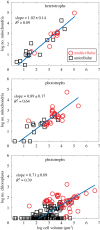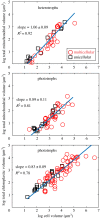Major evolutionary transitions of life, metabolic scaling and the number and size of mitochondria and chloroplasts
- PMID: 27194700
- PMCID: PMC4892803
- DOI: 10.1098/rspb.2016.0611
Major evolutionary transitions of life, metabolic scaling and the number and size of mitochondria and chloroplasts
Abstract
We investigate the effects of trophic lifestyle and two types of major evolutionary transitions in individuality-the endosymbiotic acquisition of organelles and development of multicellularity-on organellar and cellular metabolism and allometry. We develop a quantitative framework linking the size and metabolic scaling of eukaryotic cells to the abundance, size and metabolic scaling of mitochondria and chloroplasts and analyse a newly compiled, unprecedented database representing unicellular and multicellular cells covering diverse phyla and tissues. Irrespective of cellularity, numbers and total volumes of mitochondria scale linearly with cell volume, whereas chloroplasts scale sublinearly and sizes of both organelles remain largely invariant with cell size. Our framework allows us to estimate the metabolic scaling exponents of organelles and cells. Photoautotrophic cells and organelles exhibit photosynthetic scaling exponents always less than one, whereas chemoheterotrophic cells and organelles have steeper respiratory scaling exponents close to one. Multicellularity has no discernible effect on the metabolic scaling of organelles and cells. In contrast, trophic lifestyle has a profound and uniform effect, and our results suggest that endosymbiosis fundamentally altered the metabolic scaling of free-living bacterial ancestors of mitochondria and chloroplasts, from steep ancestral scaling to a shallower scaling in their endosymbiotic descendants.
Keywords: Kleiber's law; cell allometry; endosymbiosis; metabolic theory of ecology; multicellularity; organelle size.
© 2016 The Author(s).
Figures


References
-
- Milo R, Phillips R. 2015. Cell biology by the numbers. New York, NY: Garland Science.
-
- Okie JG. 2012. Microorganisms. In Metabolic ecology: a scaling approach (eds Sibly RM, Brown JH, Kodric-Brown A), pp. 133–153. Oxford, UK: Wiley & Sons.
-
- Michod RE. 2000. Darwinian dynamics: evolutionary transitions in fitness and individuality. Princeton, NJ: Princeton University Press.
-
- Maynard-Smith J, Szathmary E. 1995. The major transitions in evolution. Oxford, UK: Oxford University Press.
Publication types
MeSH terms
LinkOut - more resources
Full Text Sources
Other Literature Sources

